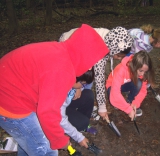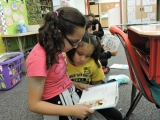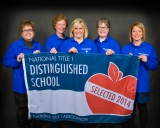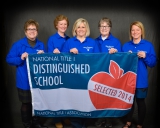-
Category 2
Selected in 2014
-
Grades: k - 5
School Setting: suburban
Town Population: 0
Student Enrollment: 450
Student Demographics:
Black/African American: 9%
Teacher/Student Ratio: 1:14
White/Caucasian: 38.6%
Hispanic: 45.9%
Hawaiian/Pacific Islander: 0.4%
Asian: 2.8%
Native American: 1%
Other: 2.2%
% Reduced Lunch: 66%
% ELL Learners: 35%
Founded: 1969 -
PRINCIPAL:
Natalie Birch -
CONTACT:
14 Forge Rd
Newark, DE 19711
302-454-2180
birchn@christina.k12.de.us
Etta J. Wilson Elementary School
Newark, DE
We are a No Place for Hate School which is an initiative with the antidefamation league. As a No Place for Hate School our goal is to reduce bias and bullying, increase appreciation for diversity and build communities of respect. No Place for hate provides a powerful model for creating more inclusive environments.
- Describe specific programs in place to ensure that families are involved in the success of your school and students.
-
Family involvement is a key element to any high performing school. We have many programs that are geared to developing a partnership with our families, below I have included our most successful programs.
* Monthly morning Parent Advisory Council meetings.
* Monthly newsletter in Spanish and in English
* PTA meetings
* Success Plan developed with parents input
* Parent Volunteer Program - Describe the most successful activity your school has initiated to strengthen ties to your community.
- Wilson participates in a variety of activities to strengthen ties in the community. We participate in the Bank at School initiative which is in partnership with Center for Economic Education and Entrepreneurship with the goal of teaching financial literacy to our k-5 students. We are a No Place for Hate School which is an initiative with the antidefamation league. As a No Place for Hate School our goal is to reduce bias and bullying, increase appreciation for diversity and build communities of respect. No Place for hate provides a powerful model for creating more inclusive environments.
- Describe your philosophy of school change or improvement.
- As a school we review data for achievement and discipline. During our data reveiws we look for negative and positive trends. Achievement gaps were identified and included in our school success plan. The goals in our plan drive our decisions throughout the year; Professionl Development, technology resources, staffing decisions, walkthroughs, observations and scheduling. During the school year we frequently review current data points to measure progress and make adjustments when necessary. This approach is used at the school level, but we also hold our teachers accountable to this data driven approach at the class level.
- What are your school’s top two goals for the next year?
-
The top two goals for the 2014-15 SY are:
* Closing the achievement gap in ELA for our ELL, special education and low income students.
* Closing the achievement gap in math for our ELL, special education and low income students - What is the single most important factor in the success of your school that others could replicate?
- At Wilson, we developed a clear and shared focus centered on high expectations for all students and staff. When problem solving we look at our school success plan and mission statement to make decisions that will help us reach our goals. We understand that in order to sustaining high levels of achievement takes focused committment from all stakeholders and as a school we need to take a critical look at our performance frequently and critically analyze it against our goals.
- Describe the program or initiative that has had the greatest positive effect on student achievement, including closing achievement or opportunity gaps, if applicable.
- I believe that an ongoing cycle of job-embedded, professional development and weekly PLCs are the most important factors for student success. Building the teachers' capacity to teach a wide variety of students using best practices is what contributes to Wilson's success. Our teachers understand how to use data to drive instruction, differentiate lessons, use a variety of strategies to reach all students.
- Explain how Title I funds are used to support your improvement efforts.
-
TItle One funds are used for a variety of purposes. Some of them include:
-Supplemental reading materials
-Technology for special education students
-Software for reading and math
-Professional Development - Identify the critical professional development activities you use to improve teaching and student learning.
- An ongoing cycle of data analysis is used in PLCs to identify the students' strengths and weaknesses and design interventions to address them. Collaborative teams are able to look at an educational problem and develop lessons/interventions to address the individual student needs.
- Describe how data is used to improve student achievement and inform decision making.
-
The triangulation of data (Cold Reads, Star and DIBELS for example) is done to get a more complete picture of student performance.
-In PLCs, an ongoing cycle of data analysis takes place. Grade level teams analyze the assessment results and flexibly group students to address specific needs for reading and math. Students are then progress monitored to determine if the instuctional interventions were successful.
-The RTI Team, meets at each End of Cycle Review to discuss students not on trajectory towards meeting their goals. -Targeted Intervention Committee: Meets weekly at 7:45 to discuss students in need of Tier 2 & 3 behavioral interventions. The following is the format followed for weekly TIC meetings
- Describe your school culture and explain changes you’ve taken to improve it.
- Wilson's maintains a positive school culture and this is one factor that makes us a highly effective school. At Wilson there is a culture of high expectations and excellence for students and staff. Teachers work together collaboratively in PLC's to tackle educational problems and to analyze data and in order to plan for instruction. Wilson's Positive Behavior Support team works collaboratively to solve climate issues. Monthly data reviews for behavioral data take place along with generating solutions. Additionally, the team provides recognition to staff members throughout the year to improve staff morale.
Stats
-
Category 2
Selected in 2014
-
Grades: k - 5
School Setting: suburban
Town Population: 0
Student Enrollment: 450
Student Demographics:
Black/African American: 9%
Teacher/Student Ratio: 1:14
White/Caucasian: 38.6%
Hispanic: 45.9%
Hawaiian/Pacific Islander: 0.4%
Asian: 2.8%
Native American: 1%
Other: 2.2%
% Reduced Lunch: 66%
% ELL Learners: 35%
Founded: 1969 -
PRINCIPAL:
Natalie Birch -
CONTACT:
14 Forge Rd
Newark, DE 19711
302-454-2180
birchn@christina.k12.de.us









